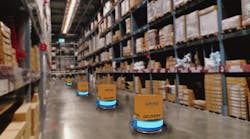Combating Labor Shortages with Automated Warehouse Solutions
The U.S. economy is currently in a high-pressure labor market, and warehouses and distribution centers (DCs) are feeling the squeeze. From workers aging out of the workforce, complications from the pandemic, naturally high turnover rates, and intense competition, DCs are in a seemingly endless battle for laborers despite increasing wages and sweetening benefits packages.
Adding to the labor problem is that 80% of DCs primarily operate with a manual workforce. Previously, warehouses were blessed with a large and cheap labor pool, allowing them to relegate tasks such as picking, packing, sorting, and operating forklifts to humans. The current labor shortage has highlighted the differences between manually operated DCs and those that have integrated automated solutions that have been able to keep up with growing e-commerce demands.
Examining the Labor Challenge
Today’s DC labor shortage isn’t unexpected—it was predicted more than a decade ago due to baby boomers, who have long made up most of the workforce, rapidly approaching retirement age. These predictions are now coming to fruition as workers aging out of roles become a leading cause of the high turnover rates, which is drastically impacting the economy. In fact, the number of Americans retiring daily has nearly doubled since the year 2000. Currently, roughly 10,000 people turn 65 each day, the standard age for retirement.
As baby boomers are moving to less physically demanding jobs, younger generations are less willing and available to replace these roles in the warehousing industry. The older generation also gained basic and applied skills through their training and experience on the job. In their absence, these workers are leaving a substantial gap in specialized skillsets that will take a long time for younger generations to recover.
While the challenge of aging employees was expected, COVID-19 brought on an unfamiliar crisis for employers, especially in the warehousing industry. Since the pandemic began, warehouses have been facing significant troubles finding labor. Unemployment benefits, fewer childcare options for parents, and fear of contracting the virus are only a handful of reasons why individuals aren’t returning to work.
For years, retail DCs have tried to keep up with growing e-commerce demands. Prior to the pandemic, demands were growing at an approximate rate of 25%. Following the pandemic, demands have grown an additional 50%. The pressure for DCs to succeed is at an all-time high, amid labor challenges that hinder warehouse operations.
DCs are struggling to keep up with high volumes of online orders to meet consumer demands for quick deliveries, which has exposed the urgent need to integrate automated warehouse solutions to maximize operational productivity and efficiency. With the holiday shopping season nearing, retail DCs are nearing another annual peak that will stress operations.
The introduction of robotic technologies provides a solution to the problems at hand to help maximize operational efficiency, increase productivity, and fill in where manual workers aren’t present in the warehouse. Robotic solutions can integrate data science to provide quick decision-making and take charge of monotonous tasks so manual labor can focus on more challenging assignments.
Let's look at several types of robotic and automated solutions that can help retail DCs simultaneously keep pace with the growing e-commerce demands while also turning around the labor shortages.
Autonomous Mobile Robots (AMRs)
In manual DC operations, there’s inefficiency in transport workflows. Autonomous mobile robots fix that by deploying workers to where they are needed, thus maximizing productivity and efficiency. In retail distribution centers, AMRs are added into the control systems, giving the robots the ability to construct their own paths around the warehouse. The robots’ sensors allow them to recognize and navigate their environment to accurately execute assignments. Autonomous mobile robots are agile, with the ability to self-maneuver around obstacles on the warehouse floor, such as lift trucks, debris, or racks.
At the end of the day, the support that AMRs bring to manual workers in the warehouse is crucial to success and significantly increases productivity and efficiency in transport workflows.
Check out AMR solutions for your warehouse.
Robotic Loaders and Unloaders
In the warehousing industry, one of the most dangerous and injury-prone jobs is manually loading and unloading product on the loading dock. Not only is this job challenging for employers to find labor in the currently small labor pool, but this job also sees an extremely high turnover rate. Robotic loaders and unloaders lower logistics costs, increase productivity and allow manual workers to be placed in positions of higher value, which helps to reduce turnover in the warehouse.
Robotic loaders and unloaders require very little manual supervision and are easy to integrate with the existing infrastructure in the warehouse. The robot’s intricate sensing and diagnostics improve the efficiency of downstream processes by discharging products in a semi-singulated flow and can stop potential problems before they happen.
Automated Storage and Retrieval Systems (AS/RS)
Automated storage and retrieval systems offer a flexible and highly scalable solution that can retrieve and transfer product in storage to save space and allow for an increased inventory through optimal storage density. Automated storage and retrieval systems are diverse and can be in systems such as shuttles, carousels, cranes, vertical lift modules, unit-loads, and mini-loads.
AS/RS technology completes its assigned tasks with accuracy, precision, and speed, making it much more productive and efficient than manually storing and retrieving product.
Check out AS/RS solutions for your warehouse.
Warehouse Execution Systems (WES)
Warehouse execution systems are capable of orchestrating nearly every aspect of the order fulfillment lifecycle: from disparate automation systems and integrated processes to labor management, workload balancing, and real-time decision-making. WES is a reactive solution that allows orders to continuously flow to maximize efficiency. Having a broad range of functionality is an advantage for this type of technology, resulting in warehouse execution systems being able to see data throughout the warehouse to adjust its functionality to meet the needs of the environment at any given time.
Automated Palletizers and Depalletizers
Retail DCs primarily use automated palletizers and depalletizers in the shipping process, as well as storing and retrieving product. Automated palletizers and depalletizers can handle a continuous flow of mixed-SKU or single-SKU pallets through the implementation of computer vision and machine learning algorithms. They help to create flexibility in retail DCs, boost warehouse productivity, and reduce worker injuries.
Check out automated palletizer solutions for your warehouse.
In addition to robotic and automated solutions helping to support manual operations in retail DCs by increasing productivity and efficiency, they also help to improve turnover rates in the warehouse. Not only are many of the jobs in the warehouse setting tedious and monotonous but some pose a high risk of injury, as well. Robotic and automated solutions solve both problems by taking primary control of tasks and placing workers in roles that are of greater importance. The integration of robotic and automated solutions in retail DCs not only enhances productivity and efficiency but can also improve employee satisfaction, which in turn improves turnover rates to help the industry recover from labor shortages.
Automation is the future, and the time to jump on board is now. Automated solutions are not trying to replace the manual workforce but aim to simplify everyday processes and ease the demand of employees. Having manual employees present in the warehouse is still necessary and important but integrating technology into the operations process is an absolute must in today’s industry.
Order volumes and consumer demands are at the highest levels since the onset of e-commerce, and as the holiday season approaches, there are no signs of demand slowing down. Robotics and automated solutions are the key to supporting DCs’ higher production volumes and maximizing operational productivity.
Thomas H. Evans, Ph.D. is robotics chief technology officer with Honeywell Safety and Productivity Solutions.
About the Author

Thomas H. Evans
Robotics CTO, Honeywell Safety and Productivity Solutions
Thomas H. Evans serves as the Robotics Chief Technology Officer for Honeywell. In this role, he is responsible for providing the technical vision and development for robotics and ASRS shuttle solutions. He works closely with the Honeywell Offering Management teams to target and develop robotic solutions to assist its customers in addressing the issues and technology advancement initiatives while driving Honeywell’s Path to Dark Warehouse development and Micro Distribution Center advancements.
In previous roles, he served as the Chief Technology Officer for Orbital Engineering, worked as a Research Associate Professor at West Virginia University, and consulted for various robotics projects for the NASA Goddard Space Flight Center. He obtained a Ph.D. and MS in Mechanical Engineering from West Virginia University and a BS in Mechanical Engineering from Wichita State University.
